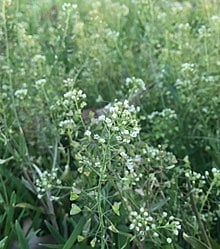Capsella bursa-pastoris

Capsella bursa-pastoris, known as shepherd’s purse because of its triangular flat fruits, which are purse-like, is a small annual and ruderal flowering plant in the mustard family (Brassicaceae).[2] It is native to eastern Europe and Asia minor,[3] but is naturalized and considered a common weed in many parts of the world, especially in colder climates,[4] including British Isles,[5] where it is regarded as an archaeophyte,[6][7] North America[8][9] and China,[10] but also in the Mediterranean and North Africa.[3] C. bursa-pastoris is the second-most prolific wild plant in the world,[10] and is common on cultivated ground and waysides and meadows.[11]
Scientists have referred to this species as a ‘protocarnivore’, since it has been found that its seeds attract and kill nematodes as a means to locally enrich the soil.[12][13]
Capsella bursa-pastoris plants grow from a rosette of lobed leaves at the base. From the base emerges a stem about 0.2–0.5 m (0.66–1.64 ft) tall, which bears a few pointed leaves which partly grasp the stem. The flowers, which appear in any month of the year in the British Isles,[11]:56 are white and small, 2.5 mm (0.098 in) in diameter, with four petals and six stamens.[11] They are borne in loose racemes, and produce flattened, two-chambered seed pods known as siliques, which are triangular to heart-shaped, each containing several seeds.[9]
